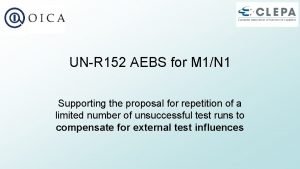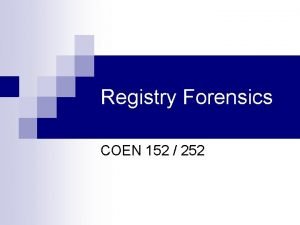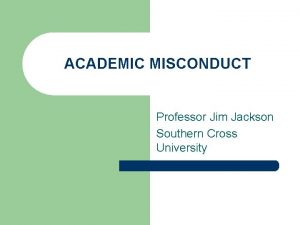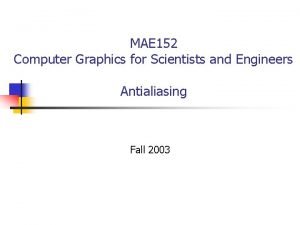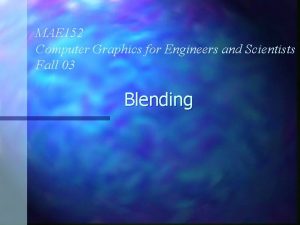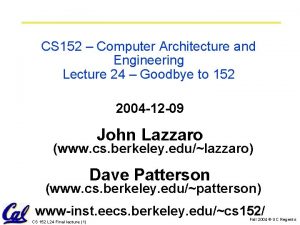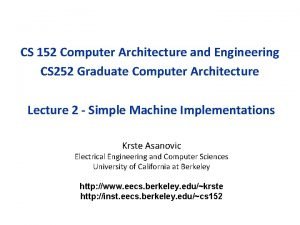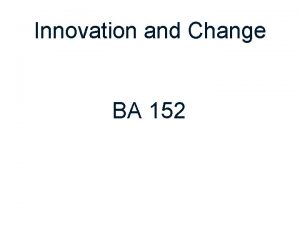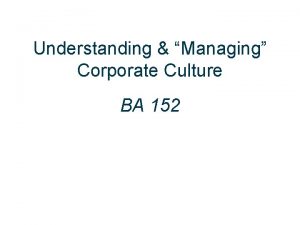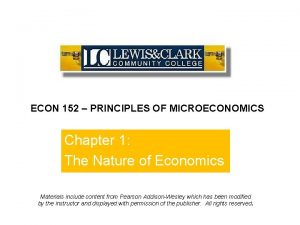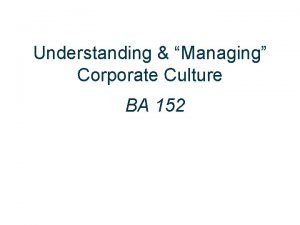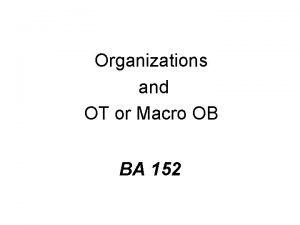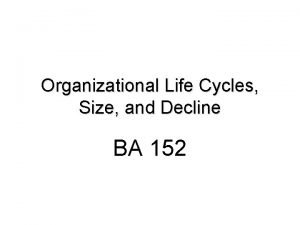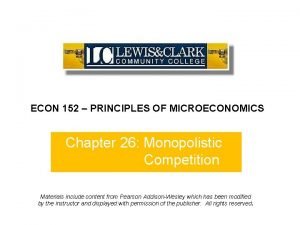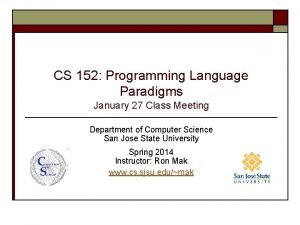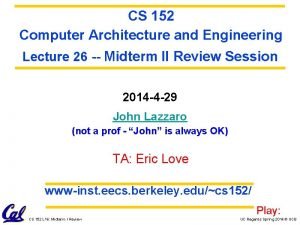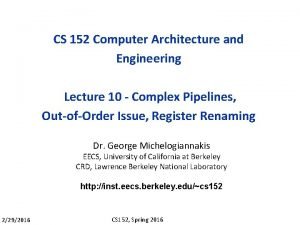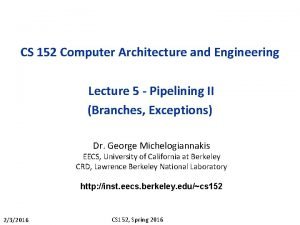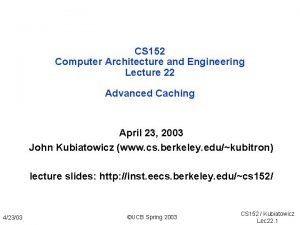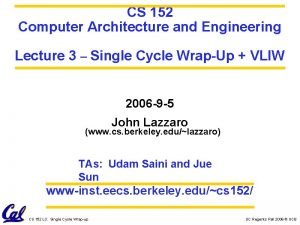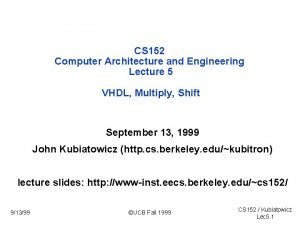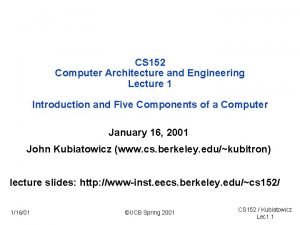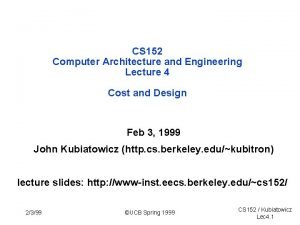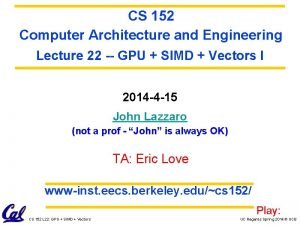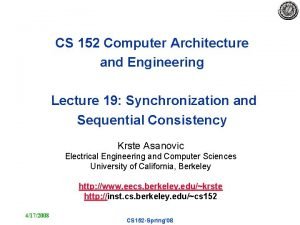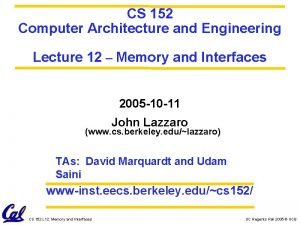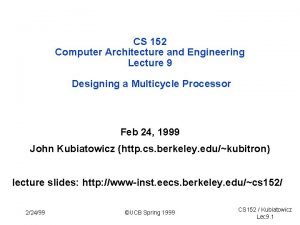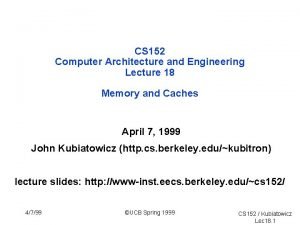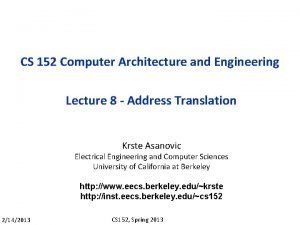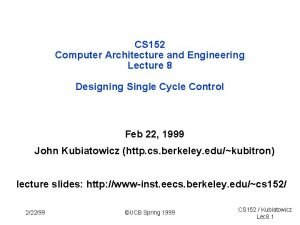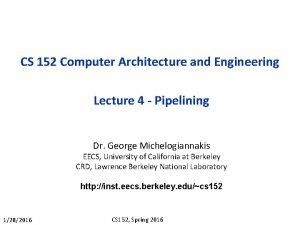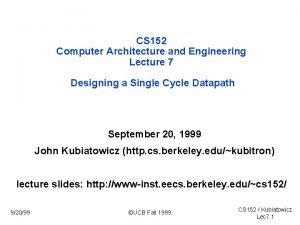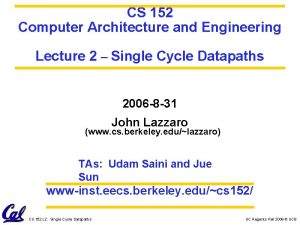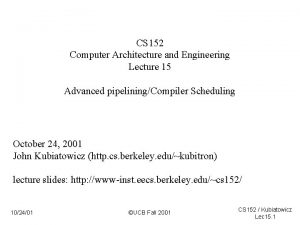CS 152 Computer Architecture and Engineering Lecture 6





























- Slides: 29

CS 152 Computer Architecture and Engineering Lecture 6 - Memory Krste Asanovic Electrical Engineering and Computer Sciences University of California at Berkeley http: //www. eecs. berkeley. edu/~krste http: //inst. eecs. berkeley. edu/~cs 152 2/10/2009 CS 152 -Spring’ 09

Last time in Lecture 5 • Control hazards (branches, interrupts) are most difficult to handle as they change which instruction should be executed next • Speculation commonly used to reduce effect of control hazards (predict sequential fetch, predict no exceptions) • Branch delay slots make control hazard visible to software • Precise exceptions: stop cleanly on one instruction, all previous instructions completed, no following instructions have changed architectural state • To implement precise exceptions in pipeline, shift faulting instructions down pipeline to “commit” point, where exceptions are handled in program order 2/10/2009 CS 152 -Spring’ 09 2

CPU-Memory Bottleneck CPU Memory Performance of high-speed computers is usually limited by memory bandwidth & latency • Latency (time for a single access) Memory access time >> Processor cycle time • Bandwidth (number of accesses per unit time) if fraction m of instructions access memory, 1+m memory references / instruction CPI = 1 requires 1+m memory refs / cycle (assuming MIPS RISC ISA) 2/10/2009 CS 152 -Spring’ 09 3

Core Memory • Core memory was first large scale reliable main memory – invented by Forrester in late 40 s/early 50 s at MIT for Whirlwind project • Bits stored as magnetization polarity on small ferrite cores threaded onto 2 dimensional grid of wires • Coincident current pulses on X and Y wires would write cell and also sense original state (destructive reads) • Robust, non-volatile storage • Used on space shuttle computers until recently • Cores threaded onto wires by hand (25 billion a year at peak production) • Core access time ~ 1 ms DEC PDP-8/E Board, 4 K words x 12 bits, (1968) 2/10/2009 CS 152 -Spring’ 09 4

Semiconductor Memory, DRAM • Semiconductor memory began to be competitive in early 1970 s – Intel formed to exploit market for semiconductor memory • First commercial DRAM was Intel 1103 – 1 Kbit of storage on single chip – charge on a capacitor used to hold value • Semiconductor memory quickly replaced core in ‘ 70 s 2/10/2009 CS 152 -Spring’ 09 5

One Transistor Dynamic RAM 1 -T DRAM Cell word access transistor VREF Ti. N top electrode (VREF) Ta 2 O 5 dielectric bit Storage capacitor (FET gate, trench, stack) poly word line 2/10/2009 W bottom electrode access transistor CS 152 -Spring’ 09 6

DRAM Architecture bit lines Col. 2 M Col. 1 N+M Row 1 Row Address Decoder N M word lines Row 2 N Column Decoder & Sense Amplifiers Data Memory cell (one bit) D • Bits stored in 2 -dimensional arrays on chip • Modern chips have around 4 logical banks on each chip – each logical bank physically implemented as many smaller arrays 2/10/2009 CS 152 -Spring’ 09 7

DRAM Packaging Clock and control signals ~7 Address lines multiplexed row/column address ~12 DRAM chip Data bus (4 b, 8 b, 16 b, 32 b) • DIMM (Dual Inline Memory Module) contains multiple chips with clock/control/address signals connected in parallel (sometimes need buffers to drive signals to all chips) • Data pins work together to return wide word (e. g. , 64 -bit data bus using 16 x 4 -bit parts) 2/10/2009 CS 152 -Spring’ 09 8

DRAM Operation Three steps in read/write access to a given bank • Row access (RAS) – decode row address, enable addressed row (often multiple Kb in row) – bitlines share charge with storage cell – small change in voltage detected by sense amplifiers which latch whole row of bits – sense amplifiers drive bitlines full rail to recharge storage cells • Column access (CAS) – decode column address to select small number of sense amplifier latches (4, 8, 16, or 32 bits depending on DRAM package) – on read, send latched bits out to chip pins – on write, change sense amplifier latches which then charge storage cells to required value – can perform multiple column accesses on same row without another row access (burst mode) • Precharge – charges bit lines to known value, required before next row access Each step has a latency of around 15 -20 ns in modern DRAMs Various DRAM standards (DDR, RDRAM) have different ways of encoding the signals for transmission to the DRAM, but all share same core architecture 2/10/2009 CS 152 -Spring’ 09 9

Double-Data Rate (DDR 2) DRAM 200 MHz Clock Row Column Precharge Row’ Data [ Micron, 256 Mb DDR 2 SDRAM datasheet ] 2/10/2009 CS 152 -Spring’ 09 400 Mb/s Data Rate 10

Processor-DRAM Gap (latency) µProc 60%/year CPU “Moore’s Law” Processor-Memory Performance Gap: (grows 50% / year) 100 10 DRAM 7%/year 1988 1989 1990 1991 1992 1993 1994 1995 1996 1997 1998 1999 2000 1 1982 1983 1984 1985 1986 1987 DRAM 1980 1981 Performance 1000 Time Four-issue 2 GHz superscalar accessing 100 ns DRAM could execute 800 instructions during time for one memory access! 2/10/2009 CS 152 -Spring’ 09 11

Typical Memory Reference Patterns Address n loop iterations Instruction fetches Stack accesses subroutine call subroutine return argument access Data accesses ve r cto ss a e cc scalar accesses Time

Common Predictable Patterns Two predictable properties of memory references: – Temporal Locality: If a location is referenced it is likely to be referenced again in the near future. – Spatial Locality: If a location is referenced it is likely that locations near it will be referenced in the near future.

Memory Address (one dot per access) Memory Reference Patterns Temporal Locality Spatial Locality Time Donald J. Hatfield, Jeanette Gerald: Program Restructuring for Virtual Memory. IBM Systems Journal 10(3): 168 -192 (1971)

Multilevel Memory Strategy: Reduce average latency using small, fast memories called caches. Caches are a mechanism to reduce memory latency based on the empirical observation that the patterns of memory references made by a processor are often highly predictable: … loop: ADD r 2, r 1 SUBI r 3, #1 BNEZ r 3, loop … PC 96 100 104 108 112

Memory Hierarchy A CPU Small, Fast Memory (RF, SRAM) B Big, Slow Memory (DRAM) holds frequently used data • capacity: Register << SRAM << DRAM • latency: Register << SRAM << DRAM • bandwidth: on-chip >> off-chip why? On a data access: hit (data Î fast memory) low latency access miss (data Ï fast memory) long latency access (DRAM) 2/10/2009 CS 152 -Spring’ 09 16

Relative Memory Cell Sizes DRAM on memory chip On-Chip SRAM in logic chip [ Foss, “Implementing Application-Specific Memory”, ISSCC 1996 ] 2/10/2009 CS 152 -Spring’ 09 17

Management of Memory Hierarchy • Small/fast storage, e. g. , registers – Address usually specified in instruction – Generally implemented directly as a register file » but hardware might do things behind software’s back, e. g. , stack management, register renaming • Large/slower storage, e. g. , memory – Address usually computed from values in register – Generally implemented as a cache hierarchy » hardware decides what is kept in fast memory » but software may provide “hints”, e. g. , don’t cache or prefetch 2/10/2009 CS 152 -Spring’ 09 18

CS 152 Administrivia • Quiz 1 Thursday in class (306 Soda) – Lectures 1 -5, closed book, no calculators or computers • Krste, special office hours, Wednesday 2/11, 2 -3 pm, 579 Soda Hall (Par Lab) • Scott special office hours, Wednesday 2/11, 4 -5 pm, 711 Soda Hall • Next week lecture 2/17 back in 320 Soda 2/10/2009 CS 152 -Spring’ 09 19

Caches exploit both types of predictability: – Exploit temporal locality by remembering the contents of recently accessed locations. – Exploit spatial locality by fetching blocks of data around recently accessed locations.

Inside a Cache Address Processor Address CACHE Data copy of main memory location 100 Address Tag 100 Data Byte 304 Data Byte Data Main Memory copy of main memory location 101 Line 6848 416 Data Block

Cache Algorithm (Read) Look at Processor Address, search cache tags to find match. Then either Found in cache a. k. a. HIT Return copy of data from cache Not in cache a. k. a. MISS Read block of data from Main Memory Wait … Return data to processor and update cache Q: Which line do we replace?

Placement Policy Block Number 11111 22222 33 0123456789 01 Memory Set Number 0 1 2 3 01234567 Cache block 12 can be placed 2/10/2009 Fully Associative anywhere (2 -way) Set Associative anywhere in set 0 (12 mod 4) CS 152 -Spring’ 09 Direct Mapped only into block 4 (12 mod 8) 23

Direct-Mapped Cache Tag Index t V Tag k Block Offset Data Block b 2 k lines t = HIT Data Word or Byte

Direct Map Address Selection higher-order vs. lower-order address bits Tag Index t k V Block Offset Tag Data Block b 2 k lines t = HIT Data Word or Byte

2 -Way Set-Associative Cache Tag t Index k V Tag Data Block Offset b V Tag Data Block t = = Data Word or Byte HIT

Fully Associative Cache V Tag Data Block t Tag = t = Block Offset HIT b = Data Word or Byte

Replacement Policy In an associative cache, which block from a set should be evicted when the set becomes full? • Random • Least Recently Used (LRU) • LRU cache state must be updated on every access • true implementation only feasible for small sets (2 -way) • pseudo-LRU binary tree often used for 4 -8 way • First In, First Out (FIFO) a. k. a. Round-Robin • used in highly associative caches • Not Least Recently Used (NLRU) • FIFO with exception for most recently used block or blocks This is a second-order effect. Why? Replacement only happens on misses 2/10/2009 CS 152 -Spring’ 09 28

Acknowledgements • These slides contain material developed and copyright by: – – – Arvind (MIT) Krste Asanovic (MIT/UCB) Joel Emer (Intel/MIT) James Hoe (CMU) John Kubiatowicz (UCB) David Patterson (UCB) • MIT material derived from course 6. 823 • UCB material derived from course CS 252 2/10/2009 CS 152 -Spring’ 09 29
 Computer architecture lecture notes
Computer architecture lecture notes Isa definition computer
Isa definition computer 01:640:244 lecture notes - lecture 15: plat, idah, farad
01:640:244 lecture notes - lecture 15: plat, idah, farad Architecture and organization difference
Architecture and organization difference Buses in computer architecture
Buses in computer architecture What is system in software engineering
What is system in software engineering Basic computer organisation and design
Basic computer organisation and design Unr 152
Unr 152 Forensics
Forensics Przedszkole 152 łódź
Przedszkole 152 łódź Law society of tasmania v richardson
Law society of tasmania v richardson Round 673 422 to the nearest hundred
Round 673 422 to the nearest hundred Mae 152
Mae 152 Mae 152
Mae 152 Cs 152 stanford
Cs 152 stanford Cs 152 berkeley
Cs 152 berkeley Ba 152
Ba 152 Ece 152
Ece 152 Ba 152
Ba 152 Lorne priemaza
Lorne priemaza Which layer of the osi model includes vlans
Which layer of the osi model includes vlans Ba 152
Ba 152 Macroob
Macroob Ba 152
Ba 152 Plasa
Plasa Econ 152
Econ 152 Ron mak sjsu
Ron mak sjsu Gfi 152
Gfi 152 Money-time relationship and equivalence
Money-time relationship and equivalence Software engineering lecture notes
Software engineering lecture notes







